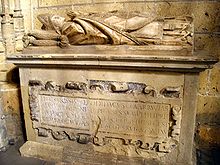- Diego de Covarubias y Leyva
-
Diego de Covarubias y Leyva or Covarruvias (1512–1577) was a Spanish jurist and bishop of Segovia.
 Diego de Covarrubias, by El Greco.
Diego de Covarrubias, by El Greco.
Contents
Life
Covarruvias was born in Toledo, Spain, on 25 July 1512. According to his biography by Schott (in the Geneva, 1679, edition of Covarruvias), his maternal grandfather was the architect of the Toledo cathedral. His master in law, both canon and civil, was Martin Aspilcueta, who gloried in having such a disciple. At the age of twenty-one, Covarruvias was appointed professor of canon law in the University of Salamanca. Later on he was entrusted with the work of reforming that institution, already venerable for its age, and the legislation which he drew up looking to this end remained in effect long after his time.
Such was the recognized eminence of his legal science that he was styled the Bartolus of Spain. His vast legal learning was always set forth with a peculiar beauty of diction and lucidity of style.[1] His genius was universal, and embraced all the sciences subsidiary to, and illustrative of, the science of law. If report be true, the large library of Oviedo, where at the age of twenty-six he became professor, did not contain a single volume which he had not annotated. In 1549 Covarruvias was designated by Charles V for the archiepiscopal see of San Domingo in the New World, whither, however, he never went.
Eleven years later he was made Bishop of Ciudad Rodrigo in Spain. In this capacity he attended the Council of Trent, where, according to the statement of his nephew, conjointly with Cardinal Ugo Buoncompagni (afterwards Gregory XIII), he was authorized to formulate the reform-decrees (De Reformatione) of the council. Pressure of other duties having prevented Buoncompagni from doing his part of the work, so the task devolved upon Covarruvias alone. The text of these decrees, therefore, formally approved by the council, we apparently owe to him.[2]
Having returned to Spain, Covarruvias was in 1565 transferred to the See of Segovia. Up to this time his extraordinary talents had been discovered in matters more or less scholastic only; they were hereafter to reveal themselves also in practical affairs of state. Appointed in 1572 a member of the Council of Castile, he was two years later raised to the presidency of the Council of State. In the discharge of this office he was eminently successful. While president of the Council of State he was nominated by Philip II for the Bishopric of Cuenca, but death prevented him from assuming his duties. Covarruvias died in Madrid, on 27 September 1577.
Works
The principal work of Covarruvias is his Variarum resolutionum ex jure pontificio regio et cæsareo libri IV;;. He wrote also on testaments, betrothal and marriage, oaths, excommunication, prescription, restitution, etc. Quite distinct in character from his other productions is his numismatic treatise, ;;Veterum numismatum collatio cum his quæ modo expenduntur, etc. (1594). His complete works have been several times edited, the Antwerp edition (5 vols., 1762) being the best. Among his manuscripts have been found notes on the Council of Trent, a treatise on punishments (De poenis) and an historical tract, "Catalogo de los reyes de España y de otras cosas", etc.
References
 Melody, John Webster (1913). "Diego Covarruvias". Catholic Encyclopedia. New York: Robert Appleton Company.
Melody, John Webster (1913). "Diego Covarruvias". Catholic Encyclopedia. New York: Robert Appleton Company.
Footnotes
Categories:- Spanish jurists
- 1512 births
- 1577 deaths
- University of Salamanca faculty
- Spanish bishops
- Participants in the Council of Trent
- People from Toledo, Spain
Wikimedia Foundation. 2010.

